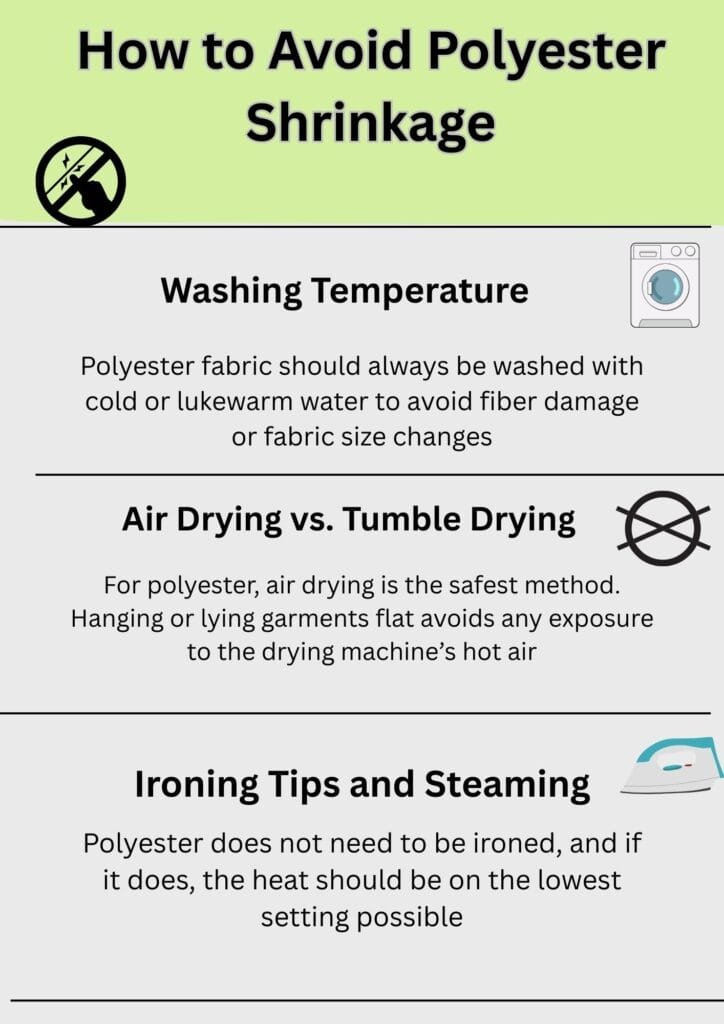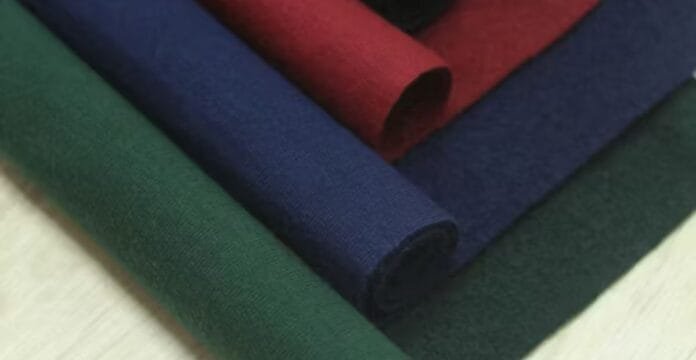Introduction
Polyester is considered one of the most widely used fabrics today. Polyester is synthetic fabric made from petroleum and is incredibly durable and low-cost. Its structure makes it resistant to stretching, wrinkles, and most importantly, shrinking. However, the question still remains: how much does polyester fabric quintessentially shrink?
The answer is not definitive as shrinkage is relative to a multitude of factors. Polyester definitely shrinks less in comparison to natural fabrics such as cotton or wool. However, when subjected to high temperatures, it is likely polyester will shrink to a certain extent. Most shrinkage occurs when polyester washes or dried incorrectly.
This guide will attempt to answer how much polyester shrinks, and what factors affect the rate of polyester fabric shrinkage, alongside essential polyester fabric care. By the conclusion, you may understand how to avert destruction to polyester clothes and understand the means to maintain the fabric volume of polyester garments.
How Much Does Polyester Shrink?
How much does polyester shrink is the question. In comparison to natural fabrics, polyester shrinks much less. The average percent shrinkage of polyester during wash and dry cycles is 1 to 2 percent. This percent shrinkage is trivial and does not impact the overall fit of the garment.
Nevertheless, polyester items are not wholly safe from shrinkage. Over time, the fabric tends to lose its integrity, mainly sweating, washing, tumble drying, or hot ironing can wreak havoc on its structure and softness and can cause polyester to shrink even up to 5-6%. Granted cotton can shrink more than 10% in hot washes, which makes polyester feel tough.
Knowing that shrinkage is not absent will better help you rationalize the fact that polyester is one of the better fabrics out there that suffers minimal shrinkage and damage.
Factors That Affect Polyester Shrinkage
Several factors determine how much polyester shrinks in different situations. Knowing these will help you avoid accidental damage.
Heat Exposure
The most important factor which influences the shrinking of polyester is the exposure to high temperatures. Polyester fibers under high temperatures will soften leading to shrinking of the cloth. Washing the garment in very hot water and drying under extremely high temperatures will automate shrinking. Similar effects can be noted with the use of an iron or steam, so long the heat applied is excessive.
Blended Polyester
Blended polyester behaves very differently. For instance, in a 50%Cotton 50%Polyester blend, the fabric is very likely to shrink due to the presence of cotton. Cotton fibers, unlike polyester, will naturally contract under heat. The polyestercotton blend with the higher percentage in polyestercotton blend will always have less shrinkage.
Fabric Quality and Weave
The polyester fabric which is used is a very important factor. The more expensive synthetic fiber with high-quality fabric and finer weaves will have a higher resistance to shrinking. The very light polyester, or with the more loosely woven will have the exposed to a higher risk of heat, is more likely to shrink. The finishing processes will also have a significant impact on the drying and washing cycle the material is exposed to.
Does 100% Polyester Shrink
Many people ask whether 100% polyester undergoes any shrinkage at all. As a matter of fact, 100% polyester shrinks the least. Doesn’t absorb water like cotton or wool. As a synthetic fabric, it lacks absorption.
That said, 100% polyester does shrink, but only when put under extreme external temperatures. Washing your polyester clothes in boiling water or putting them in the dryer on the very high heat settings may cause the fibers to contract to a certain degree. While not considerable, its effects on the shape or drape of the garment may be the major concern. Even foam does, due to its shape, trick the eye and appear overly thick. There’s no foam that can work in a safe and effective manner. This means you should wash and dry with an extreme level of care.
Does Polyester Shrink in the Wash or Dryer?
Both the washing machine and dryer can shrink fabric, but the heat retention is what differentiates the two.
Washing Polyester
Washing with cold and lukewarm water rarely results in shrinkage, dilution or deformation. Problems arise with the introduction of hot water. The extreme washing cycles of high washing temperatures results in negative implications.
Drying Polyester
Use of dryer is the most common cause of shrinkage for polyester materials. The resting heat retained within the dryer can warm the fabric to a level that is counter productive: too high. The temperatures retained may be shrunk down with setting of low or air dry.
Tips to Avoid Shrinkage
To minimize shrinkage, it is best to wash polyester using cold water and dry it using low heat settings. Another option would be to air dry polyester garments as this method is much safer.
Polyester Blends and Shrinkage
Composite fabrics behave in a distinct manner when compared to pure polyester. The interlacing of natural and synthetic fibers modifies the extent of fabric shrinkage.
50/50 Cotton-Polyester Blend
This is the most popular type of blend. A 50/50 cotton-polyester fabric is capable of shrinking more than 100 % polyester fabric, but less than pure cotton. On average, it may shrink 3 to 4 % depending on the wash and dry conditions.
Polyester with Rayon, Spandex, or Wool
Other blends react differently. Polyester-rayon blends may lose some stability and shrink more than others. Polyester-spandex blends may also shrink, but can lose elasticity when excessively warmed. Polyester-wool blends may shrink the most, because, unlike the other fabrics, wool has a natural tendency to contract under both heat and moisture.
Blend Ratios
The more polyester contained in a blend of fabrics the less shrinkage will be encountered. The natural fibers in the blend will require more attentive care in order to reduce any noticeable alterations.
How to Avoid Polyester Shrinkage
To prevent polyester from shrinking, it is advised to practice proper care techniques with the fabric.

Washing Temperature
Polyester fabric should always be washed with cold or lukewarm water to avoid fiber damage or fabric size changes. Washing polyester with hot water is the greatest reason polyester shrinks in the wash.
Air Drying vs. Tumble Drying
For polyester, air drying is the safest method. Hanging or lying garments flat avoids any exposure to the drying machine’s hot air. If using a dryer is a must, chose the low-heat or air-dry option.
Ironing Tips and Steaming
Polyester does not need to be ironed, and if it does, the heat should be on the lowest setting possible. Always put a cloth in between the iron and the polyester to avoid damage. With the steamer, the nozzle should be kept a certain distance from the fabric.
How to Shrink Polyester on Purpose (If Desired)
At times, it may be possible to want the polyester to be shrunk in order to alter the fit. Even though polyester is known to not shrink, it is possible with heat.
Step-by-Step Method
- Wash the spolyester garment in hot water.
- Then, put it in the dryer on a high-heat cycle.
- After every 10 minutes, check the garment until it reaches the size desired.
Risks of Shrinking Polyester
Warning: shrinking polyester can irrevocably damage the fabric’s fibers. Overheating will cause the fabric to distort, melt, and become rough. Attempt this with caution.
Polyester vs Other Fabrics Shrinkage Comparison
The comparison of polyester with other fabrics do tend to show the greater benefits having polyester,

Polyester vs. Cotton
Cotton shrinks and becomes thicker – especially in hot water and in the dryer. In stark comparison, polyester shrinks even less. A cotton shirt, for example, can shrink by 10 percent, while polyester shrinks by only 1 to 2 percent.
Polyester vs. Nylon
Another synthetic fabric is nylon, however, it shrinks more than polyester when exposed to high temperatures. Nylon can shrink between 5 to 10 percent, making polyester the more stable choice.
Polyester vs. Linen
Another less synthetic fabric, is linen. Because it is a natural fiber, linen is highly prone to shrinkage. With proper care, it can shrink between 5 to 15 percent, making polyester the better option in shape and size retention than linen.
Conclusion
Unlike most fabric types, polyester is one of the most dependable in the aspect of shrinkage, on average approximately 1-2%, which is usually not noticeable. However, in extremes, heat can cause more drastic changes. Polyester garments can be maintained in good condition by proper care steps—washing in cold water, air drying, and ironing on low.
Knowing the percentage of shrinkage helps in fabric care options. If you are trying to deliberately shrink the fabric, the principle of controlled exposure to heat remains. Polyester garments will remain protective, comfortable, and will not lose their shape when take.
FAQs
Does polyester shrink after the first wash?
No, especially when washed in cold water, polyester does not typically shrink after the first wash. Heat is the only way to shrink the fabric.
Can polyester shrink permanently?
Yes, the fabric shrinks permanently. Polyester does not return to its original size and shape.
Does polyester shrink more than cotton?
No, cotton shrinks more than polyester. Cotton can shrink considerably, while polyester has more resistance to shrinkage.
Does dry cleaning shrink polyester?
No, polyester is rarely shrunk by the dry cleaning process. As the process does not use water and heat, and instead uses chemicals, it is less aggressive to polyester.



